Three Cup Chicken (San Bei Ji)
Three cup chicken is a classic Taiwanese chicken dish called San Bei Ji. Chicken wings are simmered with a cup of the each 3 ingredients: soy sauce, rice wine, and sesame oil. Thai basil adds an amazing aroma and taste. Don’t miss out this popular Asian chicken recipe from Taiwanese cuisine.
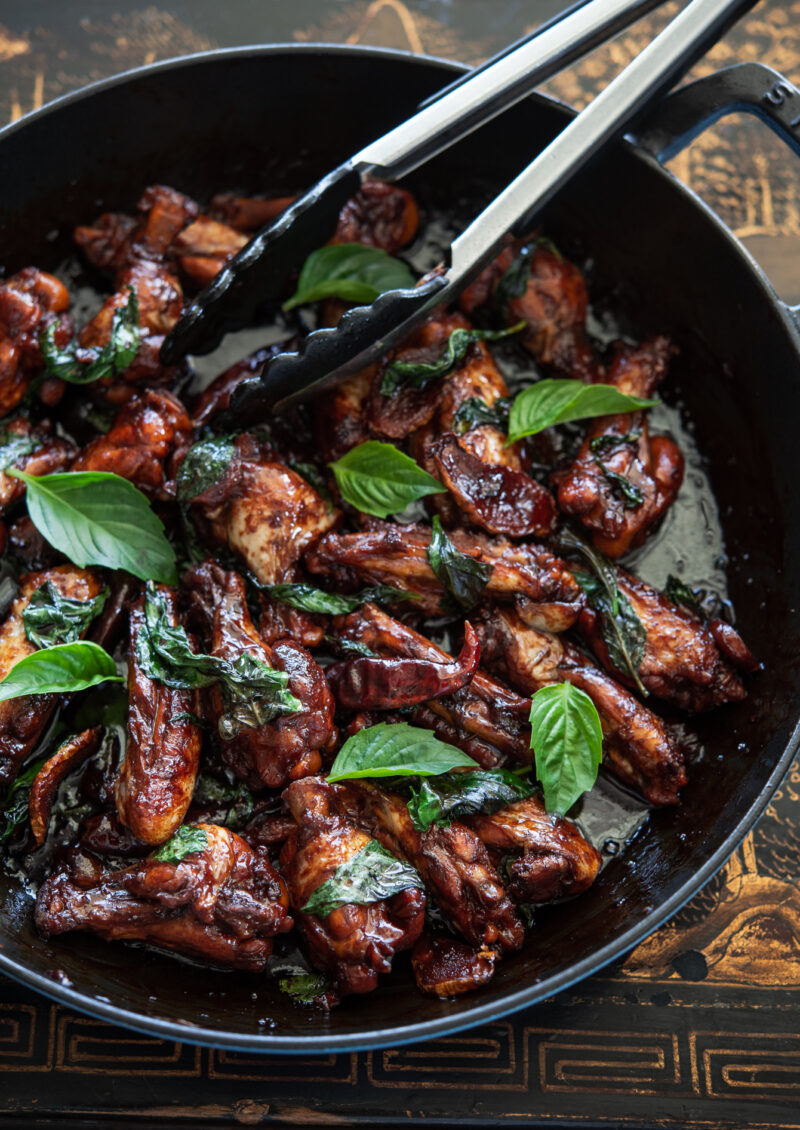
When my husband and I were newlyweds, we moved to Taipei after we both finished college so that my husband could take a Mandarin Chinese language program for 1 year at National Taiwan Normal University. Although our time in Taiwan was short, we met wonderful Taiwanese people and had the most delicious Chinese dishes there.
I had this 3 cup chicken (San Bei Ji, 三杯鸡) for the first time in 1996 when we were invited to a local Taiwanese home for a dinner. The fragrance of Thai basil mingled in chicken wings in a very dark sauce was very foreign to me at first, but it hit me with a taste sensation. I loved everything about it – flavor, texture, and even the dark look!
Crunchy Taiwanese popcorn chicken is another popular dish using Thai basil. Don’t miss out this all-time favorite Taiwanese street food.
What is Three Cup Chicken?
- San (三) = three
- Bei (杯) = cup
- Ji (鸡) = chicken
Traditionally, 3 bei ji is made with one cup each of three liquids – soy sauce, rice wine, and sesame oil. Then chicken pieces are added and braised with the liquids in a clay pot. In the modern adaptation of 3 cup chicken recipe, you don’t have to use exactly one cup of each liquid, and the addition of basil, garlic, ginger, and chili bring more flavor to the dish.
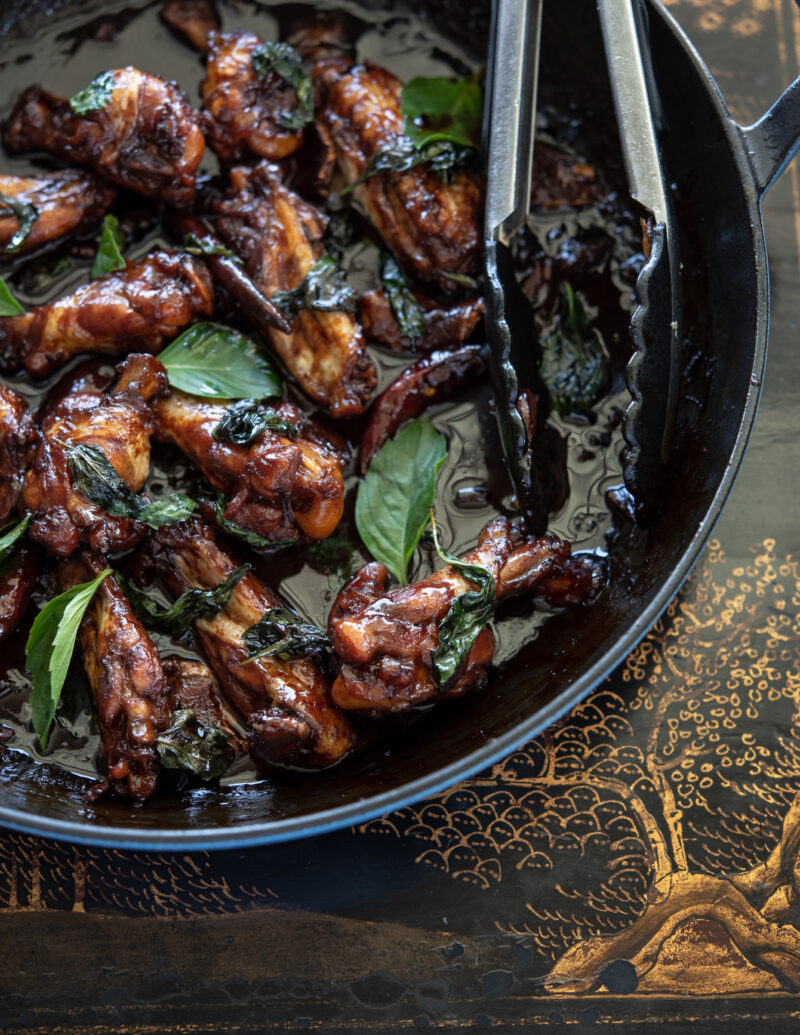
3 Cup Chicken Ingredients and Substitutions
- Chicken – Bone-in chicken is more suitable than boneless for making san bei ji recipe. It brings a deeper flavor to the dish since you will simmer and coat the chicken in the sauce. For those of you shopping in U.S. grocery stores, I recommend what are often labelled “chicken party wings.” You can use bone-in chicken thighs or drumsticks instead, but I found this dish is better with party wings since they will cook quicker and taste better with the glaze-like sauce.
- Thai basil – Fresh Thai basil delivers a slightly different fragrance and taste than the common sweet Italian basil. You can tell the difference by the color of the stem. Thai basil has a dark purple hue on the stem and has a peppery taste and almost licorice-like fragrance on the leaves when you smell them. Most Asian grocery stores carry fresh Thai basil and luckily, it is inexpensive. You can use Italian basil if you can’t find Thai basil.
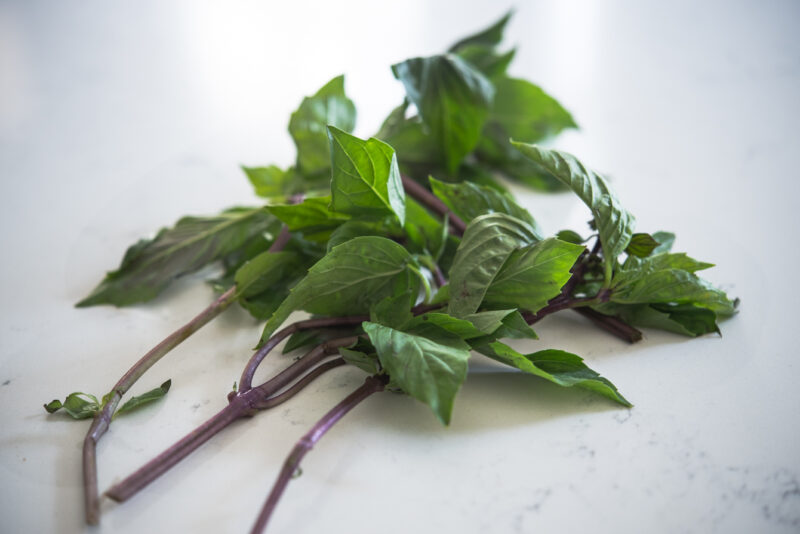
- Dark Soy Sauce – It’s commonly used in Chinese cuisine to add color and flavor to the dish. It has a thicker consistency and richer taste than regular soy sauce, but you can use regular soy sauce if you have to.
- Soy Sauce – This will season the dish over all.
- Rice Wine – Preferably Chinese shaoxing wine. If not, use any rice wine, or substitute with white wine.
- Sesame Oil – Traditionally chicken were seared in sesame oil first before adding the liquid. However, sesame oil has a low smoking point, so I recommend mixing it with vegetable cooking oil to increase the smoking point when you cook the chicken. I prefer dark sesame oil, along with Thai basil, to bring out more flavor and fragrance.
- Garlic – Use whole cloves or slice them in half. They become mellow and sweet in the sauce after the dish has simmered. Adjust the amount depending on your preference.
- Ginger – A few slices of fresh ginger adds a sharpness to the dish. You can substitute 1 tsp of ginger puree or 1/2 tsp of ginger powder.
- Dried Chilies – They add a subtle heat to the dish. You can omit them if you prefer.
- Sugar – It adds a hint of sweetness and balances the over-all flavor in the dish.

Recipe FAQs
Can I use boneless skinless chicken parts instead?
Although I highly recommend using bone-in chicken parts, preferably party wings, to get the best result and taste, you can certainly use boneless, skinless chicken breast or thighs. Reduce the amount of soy sauce (about 25%), and shorten the simmering time if you are doing so.
What herb can I use if I can’t find Thai Basil?
Thai basil is the key ingredient to get the flavor of San Bei Ji, so there’s not an easy substitute. However, you can use Italian basil leaves and Korean perilla leaves (use them both if you can) if you don’t mind a slightly altered taste. You should use a greater amount of them than is specified if you are substituting. Fresh Thai basil is commonly found in many Asian grocery stores. They are also easy to grow in a pot if you can get seeds and don’t mind planting them.
Do I have to cook in a clay pot?
If you want to prepare it the traditional way, use a clay pot. But any pot, pan or wok that has a heavy lid would work, too.
How to Make Taiwanese Three Cup Chicken (San Bei Ji)

Trim off the extra loose skin from the wings with a pair of scissors.
I like to trim off the extra loose skin from the chicken wings with a pair of scissors. This will reduce the amount of fat and help maintain a lighter taste in the sauce without being too greasy.

Heat oil and a tablespoon of sesame oil in a large pan over medium-high heat. Brown chicken wings until slightly golden. Add the garlic and ginger slices; toss well.
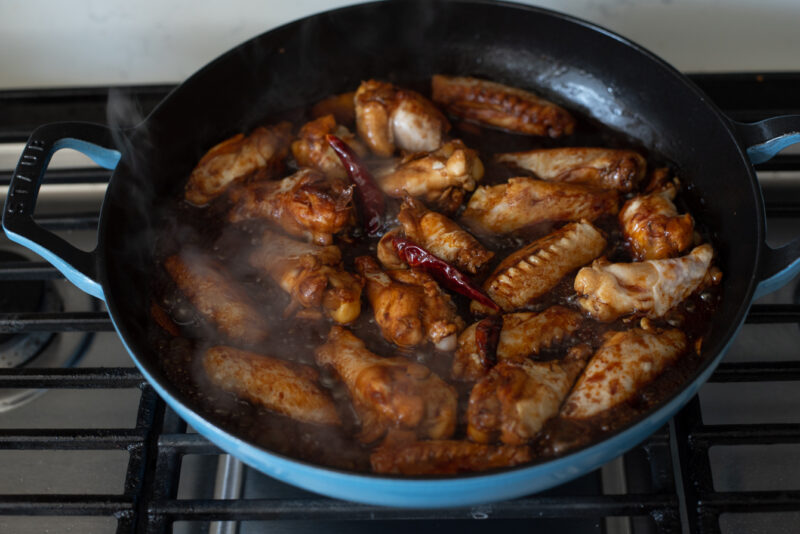
Splash in some rice wine. Add soy sauce, dark soy sauce, sugar, and dried chilies (optional); toss well until all the wings are coated.
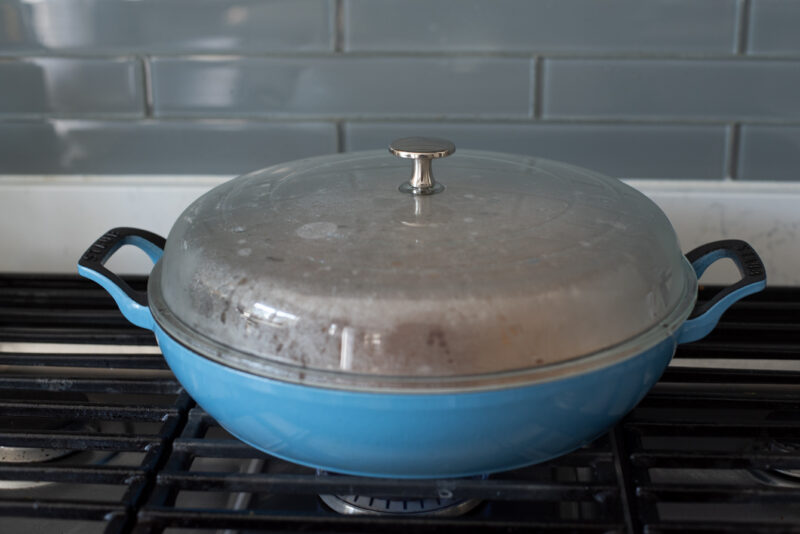
Reduce the heat to medium and cover with a lid. Simmer the wings in the sauce for 15 minutes.
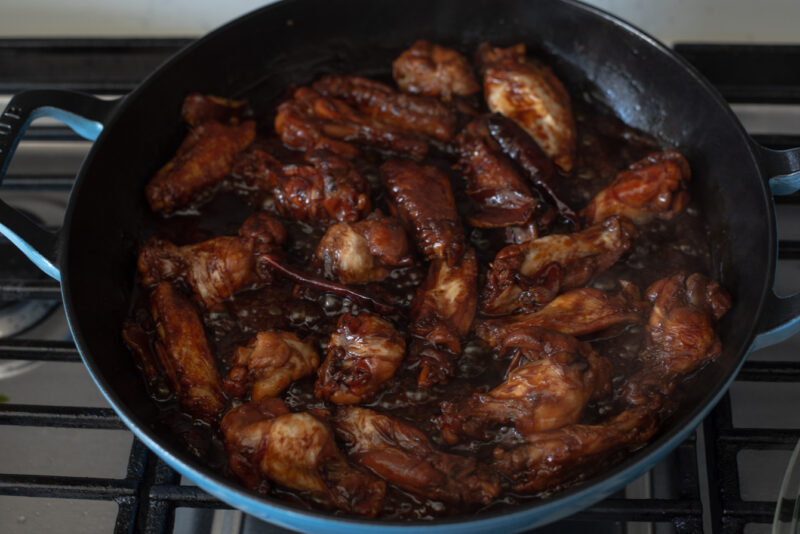
Uncover and increase the heat to high. Continue to cook to reduce the sauce a little, about 3 minutes.
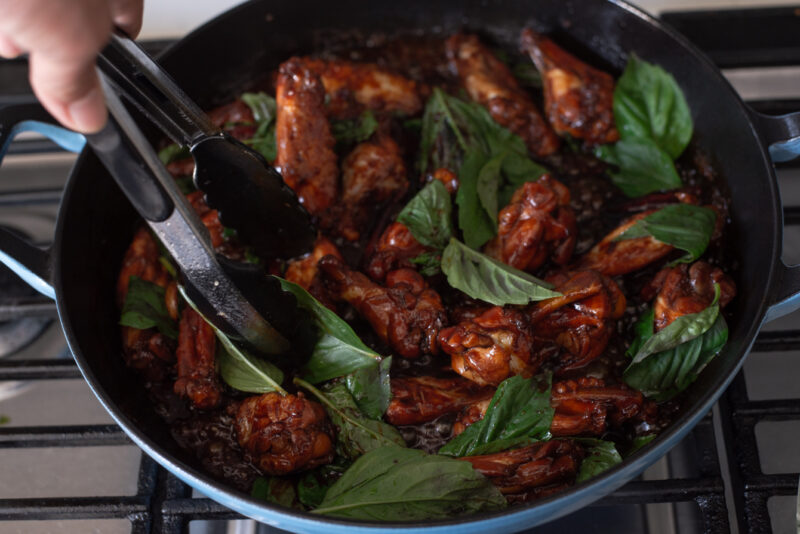
Add the fresh Thai basil leaves (as much as you want) and stir. Remove the pan from the heat.
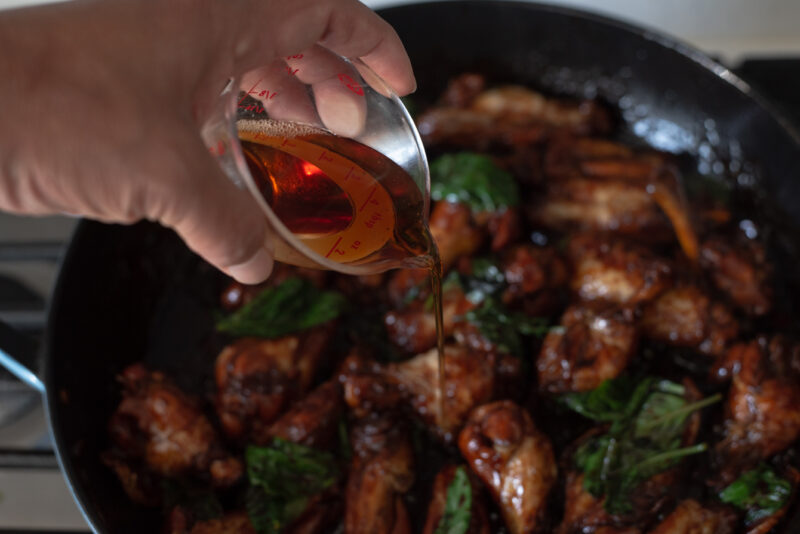
Drizzle in 2 tablespoons of sesame oil and let the chicken rest for 5 minutes before you serve. The sauce will thicken more as it rests.
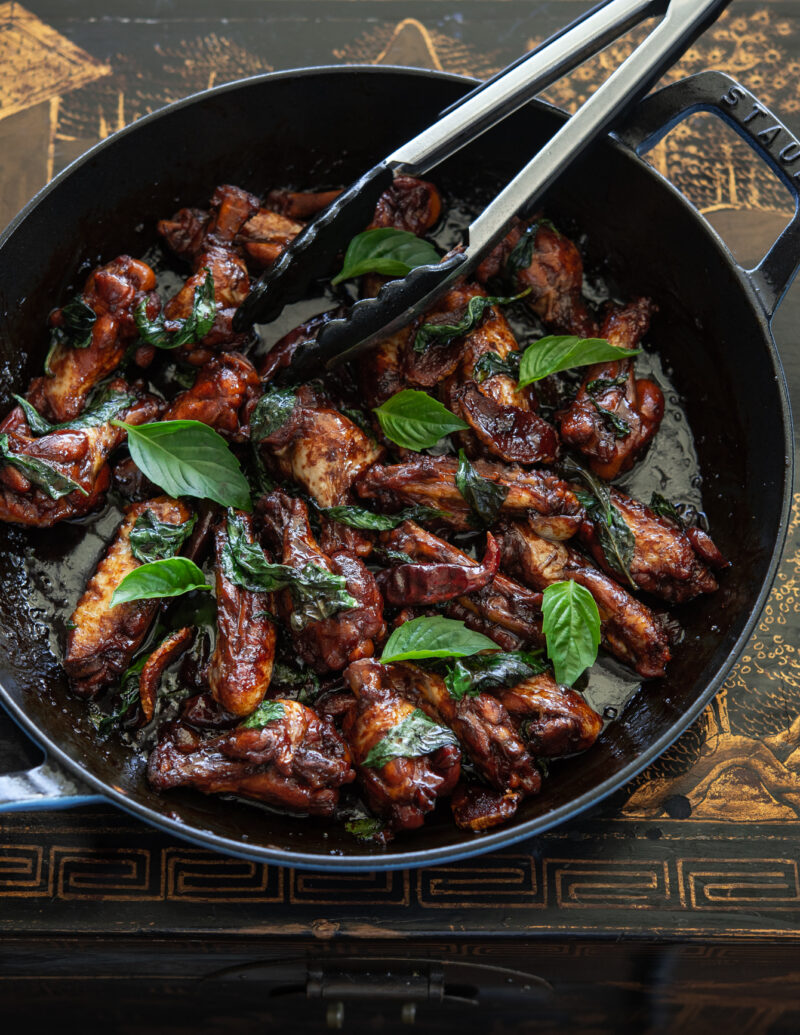
Serving Suggestion
It is best to serve San Bei Ji hot, and eat it all–don’t plan on saving leftovers. Serve with freshly steamed rice or corn rice. Don’t forget to spoon some of the sauce from the pan and drizzle it over your chicken and rice. Enjoy not only the wings, but the wilted basil and the garlic pieces as well.
Side Dish Recommendation:
More Chicken Recipes
- Korean Fried Chicken (For Chimaek)
- Chicken in Adobo (Filipino Style)
- Dakdoritang (Spicy Korean Chicken Stew)
- Kung Pao Chicken (Spicy Sichuan Chicken)
If you try this recipe, Please take a moment to leave a rating and comments below. I love hearing from you, and it helps other readers, too.

Three Cup Chicken (San Bei Ji)
Ingredients
- 2 1/2 lb chicken party wings
- 2 tablespoon oil
- 3 tablespoon sesame oil, divided
- 4-5 thin slices fresh ginger
- 10 cloves garlic, sliced in half
- 4-5 dried red chili, optional
- 1/2 cup shaoxing wine (Chinese rice wine)
- 3 tablespoon soy sauce
- 1 1/2 tablespoon dark soy sauce
- 2 tablespoon sugar
- 2 cup Thai basil, loosely packed
Instructions
- (Optional but recommended) Trim off the extra loose skin from the chicken party wings with a pair of scissors. Discard the skin.
- Heat oil and a tablespoon of sesame oil in a large pan over medium-high heat. Brown chicken wings until slightly golden. Add the garlic and ginger slices; toss well.
- Splash in some shaoxing rice wine. Add soy sauce, dark soy sauce, sugar, and dried chilies (optional); toss well until all the wings are coated. Reduce the heat to medium and cover with a lid. Simmer the wings in the sauce for 15 minutes.
- Uncover and increase the heat to high. Continue to cook to reduce the sauce a little, about 3 minutes. Add the fresh Thai basil leaves (as much as you want) and stir. Remove the pan from the heat.
- Drizzle in the remaining 2 tablespoons of sesame oil and let the chicken rest for 5 minutes before you serve. The sauce will thicken more as it rests. Serve hot with rice.


Oh my, chicken wings at a whole different level. So tasty and not so difficult. I hust used frozen party wings and they were great!
Glad that you liked it. These wings are one of my family favorites.
Outstanding flavors, great presentation. Excellent recipe, easy to follow, easy to understand and superb taste. I did sub chicken thighs and added about 1 tbsp Sambal, and could have added more, but for my wife this was perfect.
I hope you continue with recipes that are flavorful, healthy and can be made by people who like to cook, but are far from professional chefs.
Thank you for your sweet comment, Jake.
I’m glad that you liked this dish. Adding a little bit of sambal sounds delish! Yes, I will keep working hard to make new recipes that are easy and delicious. Thanks!
Great looking dish! And petty to prepare — great for weeknight cooking. I’m lucky enough to have some great specialty markets a few miles from my house, so getting Thai basil is no problem. I’m out of dark soy sauce, so I’ll pick up some of that, too. 🙂 Really like this recipe — thanks.